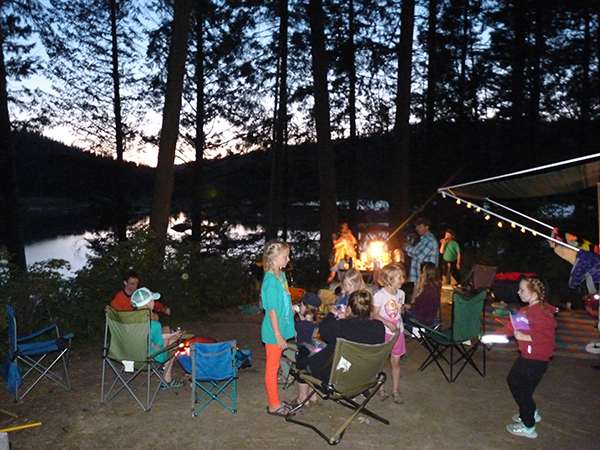What happens when four families—including eight adults and 10 children ages 1-11—go camping together over Memorial Day weekend? Fun, adventure, and lessons learned. Here are fundamental ideas that helped our trip succeed.
- Plan a trip with like-minded families. My three girlfriends and I are all like-minded women—outdoorsy, non-makeup wearing women in the 38-42 age range; our children attend the same school; and we live within a half-mile radius of each other. Our children and husbands mesh well too.
- Choose a kid-friendly campground and reserve campsites next to each other. Kid-friendly means lots of activities that children can easily walk to: a lake with a dock and small beach, hiking trails, meadow, etc. Reserve sites next to each other or across the road so it’s easy for kids to gather and play.
- Keep expectations simple and plans easy. Every family was arriving to the campground at different times or days. We decided that Saturday would be the day to stay around our campground to swim, kayak, fish and hike.
- Establish rules and boundaries for the children. Our group rules were: 1. No child can go to the lake without an adult; 2. You must wear a PFD whenever you’re on the dock, in the water, or in a kayak; 3. You cannot enter another family’s trailer or tent; 4. Tell an adult when you’re going somewhere else, whether it’s to another campsite or bathroom.
- Be a village safety-net. Everyone kept their eyes on each other’s children and practiced fresh-air parenting—allowing kids to be independent (toddler excluded) and free to explore while hovering as needed to ensure safety and well-being, whether it was around the campfire, in the hammock, at the dock, or in a kayak.
- Treat all the kids as if they were your own, and understand that no one’s children or marriage is perfect. Help each other as much as you can with child supervision and attending to needs (e.g., Band-Aids, applying sunscreen). Also, don’t take parenting so seriously that you can’t laugh at yourself. Give yourself a break: everyone’s child sometimes (or often) doesn’t listen to his/her parents, and all couples have their flashpoints and pet peeves with each other.
- Plan only one shared meal as a group. For Saturday night we had a BYO food for campfire cooking (e.g., hot dogs) and side-dish potluck. For S’mores, each family contributed ingredients to the community table.
- Bring supplies that can be shared. Hammock, water squirters, swim floaties, sand toys, glo-sticks, art supplies, stuffed animals, books, scooters, kayaks.
- Decide which gear items are non-negotiable, and don’t over pack. With a toddler along, my friend Erin regretted not bringing their stroller. “I never got to sit down,” she says. For my family, our PFDs, Frisbee and art supplies are never left behind.
- Plan easy, off-site excursions. At Heyburn State Park, this meant a quick scooter ride for the kids while parents walked along the Trail of the Coeur d’Alenes, followed by picnic lunch and swimming at the beach.
- Be flexible, creative, and intentional about meaningful conversations and activities. Kids bonded over fascinating, yet simple experiences such as poking a dead catfish with a stick or spotting a muskrat. Around the campfire, we asked questions: Who can tell us a good joke? What is your favorite camping memory?
- On check-out day, everyone keeps to their own schedule. Parents are busy packing-up and loading vehicles after breakfast. Our only official activity was to take group photos, because by then it felt like camping with a big extended family.
Amy S. McCaffree is Special Section Editor and “Out There Kids” columnist. You can follow her on Facebook @AmyOutdoorsSpokane.














